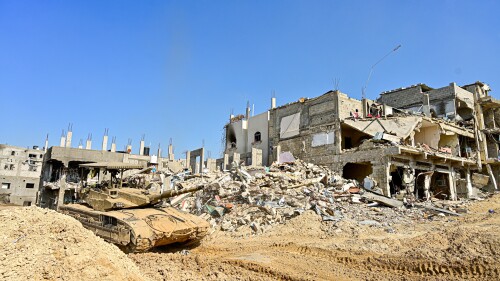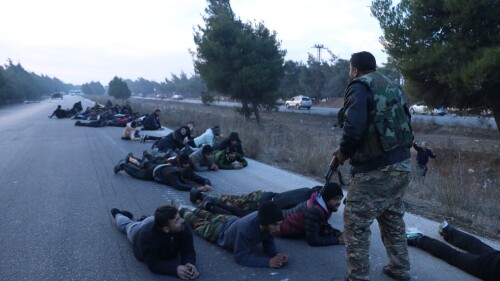Israeli aircraft and artillery this week carried out what the Lebanese media described as the “densest bombardment of a single location” in southern Lebanon since the commencement of the current round of hostilities between Jerusalem and the Lebanese Hezbollah movement on October 8, 2023.
The targets were located in the area of Wadi Saluki, well known to Israelis as the site of a bloody battle in the last days of the 2006 war.
The bombardment of Wadi Saluki is the latest episode in the controlled but intense confrontation currently taking place on the northern border.
Civilians on the Border Affected
Civilians have largely left the area on both sides of the border. Approximately 86,00 Israelis have departed the border communities. Those who have stayed are in danger of being targeted by Hezbollah teams using anti-tank guided missiles.
The bombardment of Wadi Saluki is the latest episode in the controlled but intense confrontation currently taking place on the northern border.
On January 14, Mira and Barak Ayalon were killed in the northern village of Kfar Yuval, when Hezbollah launched an anti-tank guided missile (ATGM) at their home. Missiles were also fired at Misgav Am, Avivim, Yiron, Zarit, and Shomera during the week.
The deliberate targeting of civilians by Hezbollah is contrary to all laws of war, though little reference to it or condemnation of it may be found in the global media or from Western leaders. On the Lebanese side of the border, around 100,000 people have also left their homes in the wake of the fighting. Hezbollah has occupied many of the deserted houses.
The northern border area is today an active combat zone. About 170 Hezbollah fighters have been killed since October 8, along with 19 members of other terror groups, and 19 civilians, including three journalists. Israel has lost nine soldiers and six civilians.
US presidential envoy Amos Hochstein visited Israel and Lebanon last week, in an attempt to find a diplomatic solution to the current impasse. His visit appears to have yielded little. From the outset, the US administration has been determined to prevent the descent of the Israel-Lebanon front to all-out war.
There seems little scope for successful diplomacy, however. US and French envoys favor a negotiating process that would conclude with the departure of Hezbollah’s forces from the border area to the northern side of the Litani River, according to regional media reports.
From the Israeli point of view, the problem is that diplomatic processes generally require concessions on both sides. The systematic violation of UN Security Council Resolution 1701, however, has come from the Lebanese/Hezbollah side alone.
Israel’s stance is in accordance with the provisions of the resolution. Hezbollah, in contrast, began to rebuild its presence along the border immediately after the ceasefire that ended the 2006 war, and has maintained and increased its deployment there until today. This is in direct contravention of Resolution 1701, which requires it to stay north of the Litani.
MEDIA REPORTS suggest that Hochstein is seeking to unblock the diplomatic situation by persuading the sides to begin negotiation on the demarcation of the land border, including the resolution of 13 points of dispute. These contested areas include Ghajjar and the Mount Dov/Shebaa farms area.
From the Israeli point of view, the problem is that diplomatic processes generally require concessions on both sides. The systematic violation of UN Security Council Resolution 1701, however, has come from the Lebanese/Hezbollah side alone.
From the Israeli point of view, it appears that Jerusalem is being asked to discuss territorial concessions as a reward for Hezbollah’s unilateral violation of Resolution 1701. Hochstein appears to have made little progress on his recent visit.
It is difficult to see the current Israeli government agreeing to negotiations along these lines. Defense Minister Yoav Gallant is known to take a hawkish and uncompromising line regarding the presence of Iranian proxy militias in Lebanon and Syria.
He was in favor, according to Israeli reports, of a preemptive strike on Hezbollah in Lebanon following the Hamas attacks on October 7.
Prime Minister Benjamin Netanyahu blocked this, in line with American wishes and perhaps his own more cautious instincts regarding the employment of conventional military force. But from here to unilateral concessions, which would be seen by Hezbollah as a major achievement, the way remains out of reach.
So the diplomacy is blocked. The residents of the northern communities, meanwhile, remain unwilling to return to their homes unless the issue regarding Hezbollah’s presence is resolved. It is easy to understand why. The ATGM fire this week demonstrates once more the organization’s utter disregard for the lives of Israeli civilians.
In such communities as (now deserted) Kibbutz Rosh Hanikra, and Moshav Shtula, residents lived literally adjoining the border, often seeing Hezbollah fighters a few meters from their homes. The prospect of an October 7-type attack, but on a larger scale, is very real.
ISRAEL HAS made clear that if US and French diplomatic efforts fail to bear fruit, Jerusalem will not wait indefinitely before taking its own measures to ensure that the residents of the North can return to their homes.
For as long as a four-division maneuver was underway in Gaza, it was difficult to see a second front being opened by Israel. But now that the ground maneuver in northern Gaza is largely completed, with the 36th Armored Division leaving the Gaza Strip this week, this prospect becomes more feasible.
In the meantime, the daily clashes continue. From Israel’s point of view, in strictly military terms, the current situation is not unfavorable. The IDF (and presumably Hezbollah, too) have noted the tactical difficulties that the Shi’ite Islamist organization is facing, and the uncomfortable situation in which it has placed itself by its decision to enter the fray in support of its allies in Gaza.
The 170 fighters that Hezbollah lost is a large number. The tally creeps up every week. Hezbollah admits, by comparison, to having lost only 250 of its men in the war with Israel in 2006. In tactical encounters, the movement appears to have little response to superior Israeli intelligence, and use of drones and missiles to target its teams close to the border.
Hezbollah’s fighters’ recent combat experience was in fighting poorly armed and poorly trained Sunni Islamist militias in Syria. It is now encountering a very different enemy. As of now, at least, it seems to have little response to Israel’s tactical superiority other than to continue to target the remaining civilians in the border villages.
Hezbollah’s fighters’ recent combat experience was in fighting poorly armed and poorly trained Sunni Islamist militias in Syria. It is now encountering a very different enemy.
Beyond the border, Israel has largely abandoned the tacit “rules of engagement” that emerged in the post-2006 period. Razi Mousavi, the Iranian Revolutionary Guards Commander killed on December 25 in the Sayida Zeinab area south of Damascus, was the most senior IRGC officer to be assassinated since the killing of Quds Force commander Qassem Soleimani by the US in 2020.
The killings of senior Hezbollah officials Wissam al-Tawil and Ali Hussein Burji followed in quick succession. The assassination of senior Hamas official Saleh al-Arouri in Beirut demonstrated Hezbollah’s inability to ensure the safety of its Palestinian guests, even in its inner heartland.
Observers of events in Syria report ongoing strikes in that country of an unprecedented intensity, all targeting cargo trucks, infrastructure, and individuals involved in the process by which Iran supplies weaponry to its militia proxies.
It is interesting to note that Hezbollah-associated Arabic media channels – Al-Manar, al-Mayadeen, and al-Akhbar, are nearly silent on the fighting in the North, while giving saturation coverage to events in Gaza, and much attention to developments in the Red Sea and Iraq. Evidently, Hezbollah sees little to celebrate in the current uncomfortable reality in which it can neither escalate nor climb down, even as its forces continue to absorb losses.
The situation on the border remains unresolved, with the prospects for escalation very real, in the event of a continued diplomatic impasse. Israeli preemptive action is likely to come only after the situation in southern Gaza transitions to a lower-intensity counter-insurgency against remaining Hamas pockets of resistance.
In the meantime, however, the tactical advantage in the North appears to be on Israel’s side, as the IRGC’s Lebanese proxy finds itself in an exposed position, with neither advance nor retreat currently possible.








